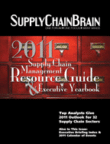
Visit Our Sponsors |
|
|
|
|
|
|
|
|
|
|
|
|
|
|
|
|
|
|
|
|
|
|
|
|
|
|
|
|
|
|
|
|
|
|
|
|
|
|
|
|
|
|
|
|
|
|
|
|
|
|
|
|
|
|
|
|

Analyst Insight: Trade compliance teams are actively revamping and augmenting their global trade management (GTM) and specifically their global trade compliance (GTC) programs to stay current with supply and demand fluctuations, growing global operations, increasing operational complexity and risk, and trade lane changes.
-Bob Heaney, senior research analyst, Supply Chain Management at Aberdeen Group
Between August and September 2010, Aberdeen Group surveyed 136 companies, documenting their processes and capabilities regarding global trade management. Among the companies surveyed, it's clear that the focus is on balancing both cost and service/risk across their growing global supply chains. A ranking of the top four pressures (respondents picked their top two) driving companies to focus on GTM include:
• Growing global operations (including sales, purchases, and distribution networks) - 33 percent
• The need to improve operational inefficiencies due to incomplete visibility or disparate systems - 33 percent
• Growing complexity of security regulations for international trade - 32 percent
• Growing risks associated with non-compliance - 29 percent
Today's global environment is clouded with an array of complex areas to manage, imbalances of volumes and sourcing mix, and government restrictions on import and exports - which all hamper the ability of the trade compliance teams to be efficient and productive. It is clear that Best-in-Class companies are delivering superior results against the key metrics. Survey results show that the firms enjoying Best-in-Class performance shared several common capability gaps (vs. all others). Best-in-Class companies were:
• 1.4 times as likely to have proactive and automated monitoring and resolution of GTM exceptions and service disruptions
• 1.3 times as likely to have the ability to meet all electronic external trade compliance/management communications requirements
• 1.7 times as likely to automate total landed cost calculation, where they have a 6-percent cost advantage over Laggards
This study demonstrates that the top companies and more highly "automated" companies have a higher success in delivering to both better cost and service metrics. By taking a more strategic view of trade compliance, these leading companies have demonstrated that they understood both costs and risks. Leading companies also understand that the active participation of the C-level executive drives superior performance.
They also know the potential of using trade compliance to reduce costs though the use of provisions such as free-trade agreements, foreign trade zones and duty deferral programs. In addition, these leaders are more connected. They have access to and are in frequent, verified connectivity to government bodies, suppliers, carriers, 3PLs and trading partners.
The Outlook
In 2011, expect to see more investments in global trade management with a focus on areas of enablement internally and externally. Connectivity and B2B collaboration will grow as companies seek to integrate with growing numbers of suppliers, trading partners and others. Additionally expect more engagement and involvement from the C-level as companies justify fresh investments and seek to connect securely outside the firewall.
RELATED CONTENT
RELATED VIDEOS
Timely, incisive articles delivered directly to your inbox.







